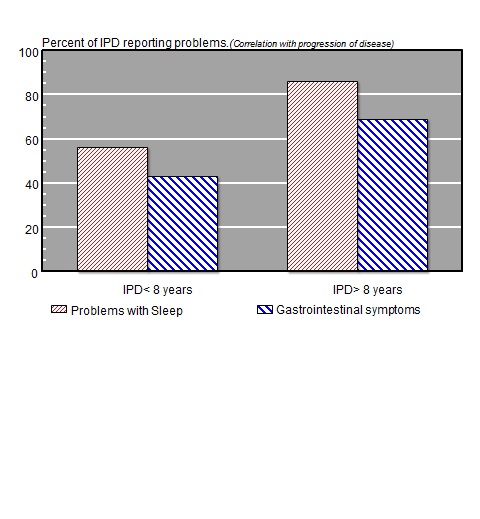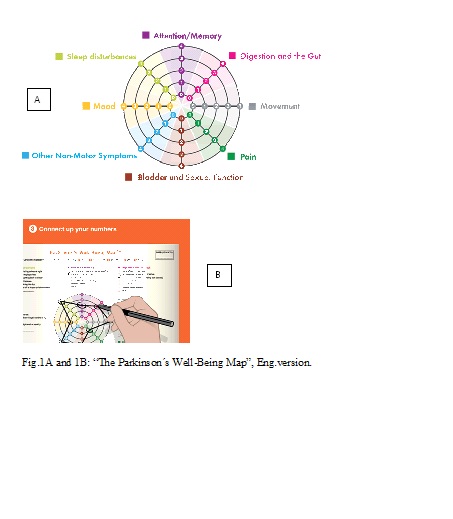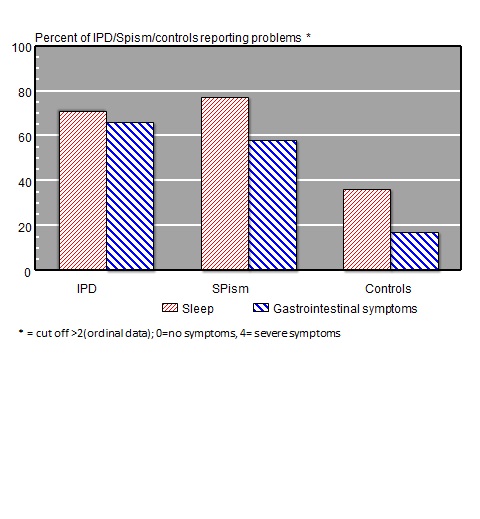Session Information
Date: Monday, June 5, 2017
Session Title: Parkinson's Disease: Non-Motor Symptoms
Session Time: 1:45pm-3:15pm
Location: Exhibit Hall C
Objective:
To evaluate self-reported frequency and amplitude of the spectra of motor (MS) and Non Motor Symptoms (NMS) presented in the “Parkinsons Well-Being MapTM ” in patients with idiopathic Parkinson´s Disease (IPD) ,secondary parkinsonism (SPism) and a conrol group matched by gender and age.
Background:
IPD is considered a multisystemic neurodegenerative disorder. It is characterized by a combination of MS and NMS. Not much is known of the NMS in SPism [1].
NMS are an important part of IPD symptoms and causes poor quality of life [2].
During disease progression NMS comprise a variety of cognitive, neuropsychiatric, sleep, autonomic, and sensory dysfunctions. The symptoms seem to increase over time.
Methods:
Patients >65 years diagnosed with IPD or SPism (1) were recently recruited from routine care visits at outpatient departments of two medium-sized county hospitals in southern Sweden. In parallel a control group matched by age and gender was recruited.
Self-registration was performed by patients prior to the visit using The “Parkinsons Well-Being MapTM .
The study was approved by the Regional Ethical Board of Linköping,Sweden in 20APR2016, Dnr2016/118-31.
Results:
A total of 208 patients were recruited to the study, 105/103 (females/males). 9 patients were excluded due to atypical parkinsonism and 14 patients due to insufficient data. Mean age was 73y (72/78; males/females).
IPD and SPism reported significantly more problems in all items (cut off>2 where 0= no/4= severe symptoms) compared to controls. Pain was more frequently registered in the IPD group than SPism (68/55%) and increased with duration of disease, (<8 y/>8 y); 52/71(%) and 66/80(%) respectively.
Very common where symptoms from movements/temper/bladder domains; 93/92(%); 50/51(%) and 64/77(%) in IPD and SPism respectively. Sleeping problems were reported twice as often in IPD and SPism 71/77(%).
Conclusions:
Both IPD and SPism presented significant more MS and NMS symptoms compared to the control group. Significant increase of some NMS symptoms followed by duration >8 years of disease. Trends towards more memory problems were seen in the SPism group compared to IPD. The “Parkinsons Well-Being MapTM ” showed to be surprisingly easy to fill in by all groups.
References: 1. Keener AM, Bordelon YM. Parkinsonism. Seminars in neurology. 2016 Aug;36(4):330-4.10.1055/s-0036-1585097. 2. Lee HM, Koh SB. Many Faces of Parkinson’s Disease: Non-Motor Symptoms of Parkinson’s Disease. Journal of movement disorders. 2015 May;8(2):92-7.10.14802/jmd.15003.
To cite this abstract in AMA style:
Ö. Skogar, M. Nilsson, S. Morberg. NonMotor and Motor symptoms in Idiopathic Parkinson´s Disease and Secondary parkinsonism The “Parkinsons Well-Being MapTM” – a useful instrument in Clinical praxis. [abstract]. Mov Disord. 2017; 32 (suppl 2). https://www.mdsabstracts.org/abstract/nonmotor-and-motor-symptoms-in-idiopathic-parkinsons-disease-and-secondary-parkinsonism-the-parkinsons-well-being-maptm-a-useful-instrument-in-clinical-praxis/. Accessed October 23, 2025.« Back to 2017 International Congress
MDS Abstracts - https://www.mdsabstracts.org/abstract/nonmotor-and-motor-symptoms-in-idiopathic-parkinsons-disease-and-secondary-parkinsonism-the-parkinsons-well-being-maptm-a-useful-instrument-in-clinical-praxis/



